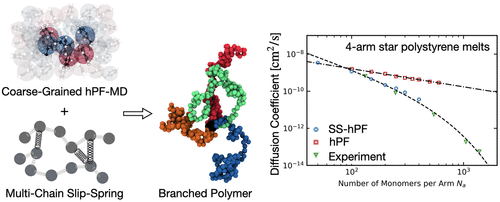当前位置:
X-MOL 学术
›
J. Chem. Theory Comput.
›
论文详情
Our official English website, www.x-mol.net, welcomes your
feedback! (Note: you will need to create a separate account there.)
Slip-Spring Hybrid Particle-Field Molecular Dynamics for Coarse-Graining Branched Polymer Melts: Polystyrene Melts as an Example
Journal of Chemical Theory and Computation ( IF 5.7 ) Pub Date : 2022-05-26 , DOI: 10.1021/acs.jctc.2c00107 Zhenghao Wu 1 , Florian Müller-Plathe 1
Journal of Chemical Theory and Computation ( IF 5.7 ) Pub Date : 2022-05-26 , DOI: 10.1021/acs.jctc.2c00107 Zhenghao Wu 1 , Florian Müller-Plathe 1
Affiliation

|
The topology of chains significantly modifies the dynamical properties of polymer melts. Here, we extend a recently developed efficient simulation method, namely the slip-spring hybrid particle-field (SS-hPF) model, to study the structural and dynamical properties of branched polymer melts over large spatial-temporal scales. In the coarse-grained SS-hPF simulation of polymers, the bonded potentials are derived by iterative Boltzmann inversion from the underlying fine-grained model. The nonbonded potentials are computed from a density functional field instead of pairwise interactions used in standard molecular dynamics simulations, which increases the computational efficiency by a factor of 10–20. The entangled dynamics is lost due to the soft-core nature of density functional field interactions. It is recovered by a multichain slip-spring model that is rigorously parametrized from existing experimental or simulation data. To quantitatively predict the relaxation and diffusion of branched polymers, which are dominated by arm retraction rather than chain reptation, the slip-spring algorithm is augmented to improve the polymer dynamics near the branch point. Multiple dynamical observables, e.g., diffusion coefficients, arm relaxations, and tube survival probabilities, are characterized in an example coarse-grained model of symmetric and asymmetric star-shaped polystyrene melts. Consistent dynamical behaviors are identified and compared with theoretical predictions. With a single rescaling factor, the prediction of diffusion coefficients agrees well with the available experimental measurements. In this work, an efficient approach is provided to build chemistry-specific coarse-grained models for predicting the dynamics of branched polymers.
中文翻译:

用于粗粒度支化聚合物熔体的滑动弹簧混合粒子场分子动力学:以聚苯乙烯熔体为例
链的拓扑结构显着改变了聚合物熔体的动力学特性。在这里,我们扩展了一种最近开发的高效模拟方法,即滑弹簧混合粒子场 (SS-hPF) 模型,以研究支链聚合物熔体在大时空尺度上的结构和动力学特性。在聚合物的粗粒度 SS-hPF 模拟中,键合势是通过迭代 Boltzmann 反演从底层细粒度模型推导出来的。非键位势是从密度泛函场计算的,而不是标准分子动力学模拟中使用的成对相互作用,这将计算效率提高了 10-20 倍。由于密度泛函场相互作用的软核性质,纠缠动力学丢失了。它通过一个多链滑簧模型恢复,该模型从现有的实验或模拟数据中严格参数化。为了定量预测以臂回缩而不是链蠕动为主的支化聚合物的松弛和扩散,增加了滑弹簧算法以改善分支点附近的聚合物动力学。在对称和不对称星形聚苯乙烯熔体的示例粗粒度模型中表征了多个动态可观测值,例如扩散系数、臂松弛和管存活概率。识别出一致的动力学行为并将其与理论预测进行比较。使用单个重新缩放因子,扩散系数的预测与可用的实验测量非常吻合。在这项工作中,
更新日期:2022-05-26
中文翻译:

用于粗粒度支化聚合物熔体的滑动弹簧混合粒子场分子动力学:以聚苯乙烯熔体为例
链的拓扑结构显着改变了聚合物熔体的动力学特性。在这里,我们扩展了一种最近开发的高效模拟方法,即滑弹簧混合粒子场 (SS-hPF) 模型,以研究支链聚合物熔体在大时空尺度上的结构和动力学特性。在聚合物的粗粒度 SS-hPF 模拟中,键合势是通过迭代 Boltzmann 反演从底层细粒度模型推导出来的。非键位势是从密度泛函场计算的,而不是标准分子动力学模拟中使用的成对相互作用,这将计算效率提高了 10-20 倍。由于密度泛函场相互作用的软核性质,纠缠动力学丢失了。它通过一个多链滑簧模型恢复,该模型从现有的实验或模拟数据中严格参数化。为了定量预测以臂回缩而不是链蠕动为主的支化聚合物的松弛和扩散,增加了滑弹簧算法以改善分支点附近的聚合物动力学。在对称和不对称星形聚苯乙烯熔体的示例粗粒度模型中表征了多个动态可观测值,例如扩散系数、臂松弛和管存活概率。识别出一致的动力学行为并将其与理论预测进行比较。使用单个重新缩放因子,扩散系数的预测与可用的实验测量非常吻合。在这项工作中,











































 京公网安备 11010802027423号
京公网安备 11010802027423号